What's Happening?
On August 14, 1975, a severe thunderstorm known as the Hampstead Storm hit north London, resulting in a record 170.8mm of rainfall within 24 hours. The intense downpour overwhelmed stormwater sewers, causing rivers to overflow and flood streets and homes. The storm led to significant disruptions, including electrical faults in the underground transport system and the evacuation of residents from flooded areas. The Greater London council later stated that the sewers were adequate but not designed to handle such extreme weather conditions.
Why It's Important?
The Hampstead Storm serves as a historical example of the challenges posed by extreme weather events, highlighting the need for robust infrastructure to manage such occurrences. It underscores the importance of urban planning and emergency preparedness in mitigating the impact of natural disasters. The event also raises awareness about the potential consequences of climate change, as similar storms could become more frequent and severe, affecting urban areas and their populations.












